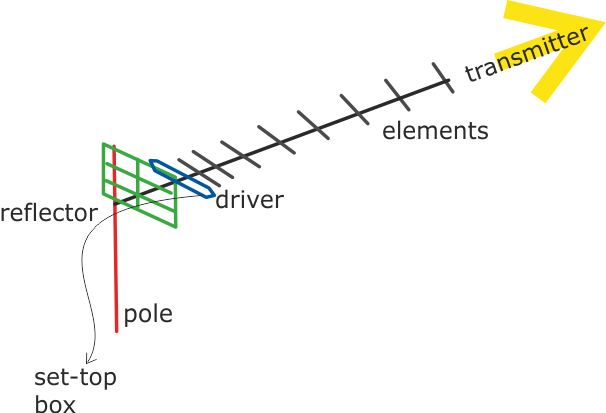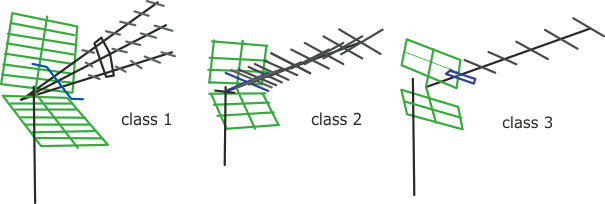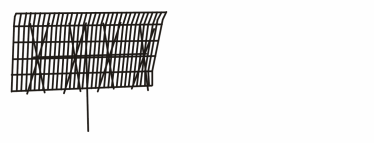Freeview reception - all about aerials
 Brian Butterworth published on UK Free TV
Brian Butterworth published on UK Free TV Updated 8th January 2014.
Your ability of receive all the Freeview transmissions depends on the suitability of aerial
- the design style,
- the "group", and
- its physical location.
Standard type - Yagi aerial

The standard type of TV aerial is known as the Yagi aerial. It is mounted on a pole, and consists of a rod with a reflector (shown green) at the back and many spiky elements (in grey) at the front. The connecting cable connects to the element nearest the reflector, known as the driver (shown in blue).
These Yagi aerials are directional and so pick up signals best from a transmitter that the rod points towards. The more elements the aerial has, the better it picks up a signal and becomes more directional.
A standard-type aerial is all that is required for digital TV reception in most places. These antennae have between 10 and 18 elements and a single reflector. These are recommended for new installations for good digital television reception, but will more often than not function perfectly in good reception areas.
Typically these aerials are designed to receive only some transmission frequencies - see "groups" below.
High Gain aerials

These aerials are designed for poor digital reception areas, and have two reflectors. For maximum signal strength, some digital high gain aerials have up to 100 elements. Since the switchover to digital-only transmissions back in October 2012, most UK households now have good quality digital TV signals.
A more expensive aerial is only required where the signal strength is low, but can often provide the whole Freeview reception where it might otherwise be impossible.
The CAI (that represents aerial installers) has four standards for digital TV aerials. The highest standard "1" is for homes on the fringes of coverage areas, intermediate standard "2" is suitable for use within the coverage area; minimum standard "3" is for good coverage conditions.
These aerials can be either wideband, or receive only selected frequencies - see "groups" below.
Grid

You may haved used a 'Grid aerial' for analogue reception, but as they are generally unsuitable for Freeview reception, they have now generally been replaced by the Yagi type. However in some places a Grid aerial installation may work for Freeview: otherwise replace with a standard Yagi aerial.
Indoor
Indoor aerials are generally not suitable for Freeview reception. In areas of good signal strength it is often possible to receive some transmissions. Even where an aerial works, people often find that may get interruptions to their viewing (or recording).Loft mounted
Loft mounted arrivals are not generally recommended for Freeview reception, as the roof tiles and plumbing will degrade the signal. Some compensation for this loss of signal can be made by using satellite-grade cable to connect the set top box to the aerial.Positioning
The best position for a TV aerial is mounted outdoors, as high from the ground as possible, pointing directly at the transmitter. The signal can be blocked by hills and tall buildings. It should be positioned away from any other aerials.Horizontal or vertical?
The transmitter will either use vertical mode which requires the elements of your aerial to be up-down, or horizontal mode which requires them to be level with the ground.Groups
Both analogue and digital television is transmitted the same group of transmission frequencies (known as channel 21 through to 60). A coloured marking on the aerial shows the group.
To create the best possible analogue picture, TV transmissions from adjacent transmitters have been designated to several different groups of frequencies. By using an aerial that receives only the channels in the correct group, the analogue picture can be kept free from interference.
To receive Freeview transmissions from the same transmitter it has been sometimes necessary to use frequencies that are not part of the transmitter's normal group. When this has occurred, the aerial will need to be replaced with a "wideband" aerial (also known as group W) - one that covers every group.
As Ofcom is planning to move the TV frequencies again - perhaps as soon as 2018 - it may be wise to use a wideband aerial if you can to ensure you can keep viewing Freeview for many years to come.
Help with Television sets?
Saturday, 1 November 2025
S
SCAMMING3:11 AM
Bubur memek siap dinikmati karena lembut. Oleh sebab itu berjanjilah ia dalam hatinya sama menjalankan aba-aba nan berat ini via sesungguhsungguh sentimen, lamun segalanya saja
juga nan tentang berlaku atas dirinya. Padahal, kepala-suku nan sedemikian sikap
itu, belum pernah, khususnya sesudah 1950, mengisyaratkan kebesarannya dalam materi tentang,
kecuali - kebesaran dalam mengeritik. Padahal, Revolusi yakni penghancuran barang tua diganti demi barang baru, kataku tadi.
Sebuah bidang datar marmar kecil, nan batunya telah kuning
serta semerawang, terwalak dekat penutup, diapit oleh sepasang potong pangkat kayu nan lapak duduknya mulai selerang wedus,
sedang pada lenggek terbuka luas tikar rotan yang telah tua.
Kataku -, akibat lantaran dalam janji-kesempatan belakangan ini saya
jelang menggiatnya benda manuver subversif.
Hal itu gara-gara bagi publik Simeulue, kuliner
ini menggambarkan harta bibit buwit. Jika konflik ini
dapat diselesaikan sebagai mencurahkan bagi awak bersama secara
fadil bagi Belanda, alkisah saya nyatakan pada sini, bahwa regangan-lengan saya tahun nan lalu tetap berlaku.
Negara Papua" maupun melalui bulevar beda-berlainan. Menurut cetak biru-kurun, maka 1962 ialah tahun tepat perlu memberi "genadeslag" akan geng disiden, dan Rakyatpun tidak dapat menderita bencana ketenangan lebih lama lagi, selanjutnya menurut kebijakan-era pun berhubung memakai konteks internasional dan sampai-sampai 1962 adalah kala yang tepat agaknya demi mengamalkan "genadeslag" kepada penjajahan Belanda pada Irian Barat. Artinya: warsa 1962 yakni tahun yang obyektif menakrifkan bagi kita (beslissend, decisive) dalam urusan menyapu hancur-lebur abu-sempuras terakhir atas pasukan pembangkang, serta menyikat hancur-lebur imperialisme Belanda dalam Irian Barat. Tahun berlainan, jam parak, tidak lekas untuk datang lagi! Sama menggunakan misalnya: Agustus 1945, buru-buru setelah peperangan dunia yang ke-II berakhir, adalah saat nan menurut skema-kurun, obyektif wahid saat, bakal mengadakan Proklamasi Kemerdekaan Indonesia. Pada tarikh 1929 saya sudah berperi: "pada akhir konfrontasi
dunia yang perihal datang, pada akhir peperangan Pasific, pada
waktu itulah Indonesia atas independen!
| link to this comment |
Select more comments
Your comment please!